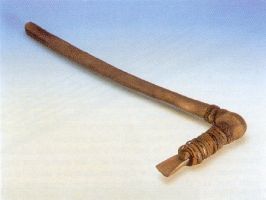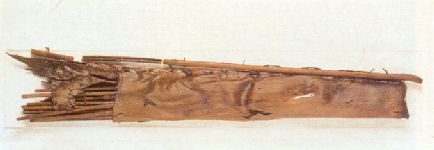The Man in the Ice
In September 1991, Erika and Helmut Simon were walking in the Alps near the Austrian border with Italy, when they came upon the body of a dead mountaineer. Only the head was visible above the ice. It appeared to be the body of a woman, and they assumed that she might have died ten or twenty years ago. In the Alps, it has sometimes been known for people to die in accidents and get enclosed by ice. The body then moves slowly down the mountain in the glacier and can emerge up to thirty years later.
They returned to the village and told the innkeeper, who in turn informed the police. In the next few days, before the body can be recovered, several people visited the site, and it became obvious from equipment found nearby, including an unusual ice-pick, that the climber may have died sometime in the last century. The body was finally released from the ice, brought down the mountain by helicopter and then taken by hearse to Innsbruck.
Suspicions that the body might be very much older were confirmed by Konrad Spindler. He examined the body, the "ice-pick" and other items found with the body. He concluded that the axe was either early bronze age or late Neolithic, and therefore that the body was at least 4000 years old. (It was later dated as late Neolithic, or about 5000 years old).
 The "ice-pick", an axe with a yew shaft and a copper blade - 24k |
 The quiver, a fur bag stiffened by a hazel rod, with fourteen arrow shafts - 22k |
The good preservation of the body, clothes and implements gives a fascinating glimpse of what life might have been like for a person living in Neolithic times in Ireland. The following items were found:
- An axe with a copper blade and yew shaft
- A bow and a quiver of arrows, two with flint arrow heads
- A small dagger in a scabbard
- A back pannier made of hazel rods, larch boards and birch bark
- Other smaller items, such as cords and flints
Fragments of the iceman's clothes were also found, and they are well enough preserved to be able to see different types of stitching used for temporary repairs, presumably by the iceman himself. They included:
- A fur cap
- A upper garment made of pieces of fur sewn together
- Fur leggings held up by a belt
- A soft leather loincloth
- Leather shoes, with a inner net of grass cords
Examination of the body allowed a possible reconstruction of the last hours of this man's life. The Neolithic people were farmers, growing varieties of wheat and barley. Two grains of barley and some wheat chaff were found in the iceman's clothing. They had domesticated animals (such as dogs, goats, pigs and cattle) and hunted wild animals such as ibex, deer and birds.
Konrad Spindler thinks that the iceman may have been a shepherd, accustomed to living for several months away from the settled community; hunting for food and to protect the herd. He may have returned to his community to find that some disaster had occurred (perhaps a violent attack, since he had four broken ribs) and fled over the mountain pass. Tired and hungry, he laid down his axe, bow and backpack on a rock ledge, and lay down to rest. He never woke up.
Book reviewed:
Konrad Spindler,
"The Man in the Ice", 1995.
See also:
Provincial Museum of Alberta: The Iceman
University of Innsbruck: The Iceman
Cruithni website | Home | FAQ | Links | Contact | Updated: 14 October 1999